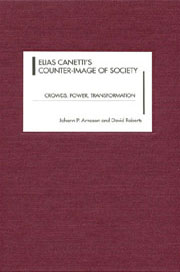2 - The Natural History of Modernity
Published online by Cambridge University Press: 05 February 2013
Summary
Elias canetti's Crowds and Power (1960) has been hailed by J. S. McClelland as the one masterpiece in the whole tradition of crowd theory since Plato (CM, 293). High praise indeed for a work which passes over this entire tradition in silence to develop a phenomenology and biology of crowds and power outside of the received categories of social psychology and political theory. It was thus a fellow-novelist, Saul Bellow, who summed up what no doubt many bewildered readers felt, when, in a thinly veiled reference to Canetti, in the guise of “this Bulgarian, Banowitch,” his hero Herzog speaks of a “gruesome and crazy book”: “Fairly inhuman and filled with vile paranoid hypotheses such as that crowds are fundamentally cannibalistic, that people standing secretly terrify the sitting, smiling teeth are the weapons of hunger, that the tyrant is mad for the sight of (possibly edible?) corpses about him.” Nevertheless, Herzog must concede “that the making of corpses has been the most dramatic achievement of modern dictators and their followers (Hitler, Stalin, etc.).” We can hardly be surprised that social scientists have kept their distance from a study which resists in such fashion theoretical appropriation. McClelland stands alone not only in his appraisal but even in his analysis of Crowds and Power. Serge Moscovici concludes his “historical treatise on mass psychology,” The Age of the Crowd, with Freud and mentions Canetti only in passing. The reason for this is not simply historical.
- Type
- Chapter
- Information
- Elias Canetti's Counter-Image of SocietyCrowds, Power, Transformation, pp. 27 - 58Publisher: Boydell & BrewerPrint publication year: 2004



